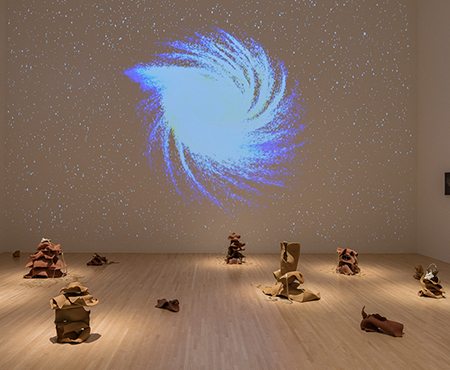
Continuing through May 5, 2024
Although presented as a cumulative installation composed of related objects crafted from different materials, wall-mounted “crystallographs,” and projected videos overhead, Kelly Akashi’s “Encounters” operates more convincingly as a collection of discrete objects surrounded by related, but not necessarily interdependent, video projections and photographs of concocted microscopic elements.
Stressing tactile properties in her earlier art, Akashi’s current collection of objects deals indirectly with the theme of touch. Working with the University of Washington Ceramics and Metal Arts Department, Akashi had students help her with three types of materials that would merge into multi-media sculptures sited on the gallery floor: folded slabs of fired flat clay; bronze castings of body parts such as hands, fingers and thumbs, and cast-glass facsimiles of similar body parts.
Twenty-one low piles of clay with bronze, wax candles, glass body parts, and indigenous species of blackberry bushes reach up eerily toward the viewer gazing down on them. Primordial, even primal in character, they may symbolize the origins of life rising from the earth or, conversely, the demise of humanity sinking into a morass of sludge. All are untitled and appear to inhabit organically the enclosed gallery area at our feet as we walk among the stacks. Inert despite their organic, fired-clay origins, the sculptures remain static given the rigid character of the bronze and glass castings. In this sense, the conglomerations are more ecological memorials than myths of origin. The deaths of older systems or civilizations is implied by the presence of one glass crown sinking into the dirt.
Projected above this random graveyard of muddy assemblages are swirling studio-generated images of outer space, galaxies, stellar constellations and other shimmering stellar objects. While the video imagery slowly shifts and changes, as if the universe was rotating in slow motion, the other walls contain a half-dozen large, mounted images of invented microscopic elements generated in the studio and darkroom. These pseudo-documents reinforce a quasi-scientific quality that makes “Encounters” feel like a science museum. Given Akashi’s statements about wanting to “map time,” one perceives the compilation of objects, projections and framed photographs as a coherent whole. However, a shortcoming that Akashi shares with many installation artists is the gradual weakening or deterioration of the individual objects’ power. In this case, the piles of sludge with glass, wax and bronze appurtenances, set on the floor as they are, relate to one another as organic units, but do not stand as unitary objects of any substantial power.
Surprisingly, the video projections have a compelling interest all their own, constantly changing, drawing us in, and compelling reflection on time, space and destination. However, the curator’s claims that Akashi’s choices of materials “work against their typical definitions — glass that reacts like a soft pillow, dirt that functions like stone, wax that substitutes for permanence —“ are debatable, given the strong presence of the trio of formal components. We are left with an enigma: time that seems stalled; space that is never-ending but to no clear purpose; and the crystallized photographs of nothing more than crystals the artist has grown and the prints she has “solarized” in the darkroom. When seen in this light, Akashi’s cogent interest in the planet and the universe remains embodied in completely imaginary constructions.
